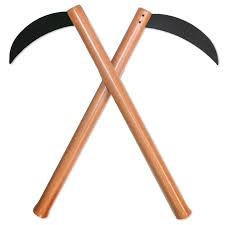The Kama is a martial arts weapon based on a farming instrument, the small scythe used for cutting rice. This weapon is used in a variety of Japanese, Filipino, Indonesian and Chinese martial arts styles.

Kama – Traditional Martial Arts Weapon
The Kama, commonly associated with Okinawan martial arts, finds its roots in China and Southeast Asia, as evidenced by ancient versions found in China and forms/Kata within Chinese arts like Kung Fu. Like other Okinawan weapons, Kama forms often reflect empty-hand techniques. Originally a traditional farming sickle, the Kama is considered challenging to learn due to the inherent danger in practicing with such a weapon.
In its traditional form, the point where the blade and handle join allows for trapping a bo, though this joint proved to be a weak point in design. Modern examples often feature a shorter handle with a blade that begins following the line of the handle and then bends to a lesser degree, known as the natagama. This modification addresses the weakness while maintaining the essence of the Kama.
In Okinawan/Japanese Kobudo, Kama are traditionally used in pairs. In basic forms, the Kama are held towards the bottom of the handle and are used to defend against opponents armed with swords or other long reach weapons such as Bo or Jo. A typical Kama technique will involve blocking an oncoming strike with one Kama then using the other to counterattack. Also both Kama can be used simultaneously to block or trap an opponent’s weapon or to deliver a double strike.
Advanced Kama forms utilize a short strap attached to the bottom of the Kama which are used to swing or spin the Kama at great speed in order to deliver an attack. This Kama jutsu technique is often referred to as the “Flying Kama” and takes a great deal of skill and coordination to master.
The Kama form in your system is from the Shinpo Mataoshi System, with structured pairs work following the format of Ippon Kumite from the karate syllabus. This integration highlights the versatility of Kama techniques within a broader martial arts context.
Sensei Pete Halloran as your Okinawan weapons instructor, bringing a wealth of knowledge and expertise to your martial arts training. His dual role on the Shizendo Technical Committee, overseeing standards within your organization, reflects a commitment to maintaining excellence and authenticity in the teachings.